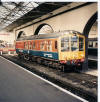Iris 2
was converted in 1991 from a Met Cam class 101 power twin unit at the R&DD to a high standard as
a test train known as "Lab 19 - Iris II" which it always had displayed on its
destination blinds. It was completely re-furbished inside. One vehicle was
equipped with a diesel generator set, kitchen and eating area and an
instrumentation area with air conditioning . The other vehicle was not to the
same high standard but had a small workshop and storage area and bunk beds for
the use on night work when stabled. I remember once spending the night on
Iris2 at Reading depot when the night job was cancelled and we had no hotel.
Work undertaken on Iris 2 when I was first involved included radio survey work
in connection with the NRN which was regularly undertaken particularly on the
GW and Southern Zones of RT. Later Iris 2 was chosen to undertake pioneering
video surveying of the whole railway, which included all lines from
Penzance to Thurso. I remember one trip from Clapham Junction Yard to Penzance
Long Rock depot - all the way down the old LSWR main line in the cab! Happy
days.
We also undertook a signal sighting survey prior to the WCML upgrade
on all lines between London and Glasgow including diversions. This was in
connection with raising the speed to 125 mile/h.
Iris 2 was retired
at the end of the 1990's but was back in action in 2004 conducting
yet more radio surveys. However, it had by then been given the all-over yellow
livery favoured by Network Rail. At least it looks better than the hideous Railtrack livery of
lime green and dark blue.
In late 2007 Iris 2 was finally retired and was
offered for sale. In March 2008 it moved to the West Somerset Railway at
Dunster, where it was re-painted green and used by the Permanent Way Department.
On August 17th 2009 The West Somerset Railway unofficial site (wsr.org.uk) had
the following information
"IRIS II heads for
Wales The two-car DMU IRIS II is about to leave for Wales. It has been stored
unused at Dunster Yard for over a year. During that time the DMU - Network
Rail Laboratory 19 IRIS II test train 901002 - was repainted by its owner from
yellow to a more heritage style green livery. Recently towed to Minehead, the
DMU will be moved to Bishops Lydeard in a few days, thence transported by road
to Barry. WSR General Manager Paul Conibeare commented "The owner, John
Buxton, is removing it to Barry to run services on the new railway, which John
has just taken over. We wish John all the best with his new venture and I am
sure IRIS II will be a popular and useful vehicle."
It now resides at the Barry
Tourist Railway where it has been refurbished and turned into a
comfortable passenger environment. Look
here for some
technical details of the two vehicles and a summary of its recent movements


























